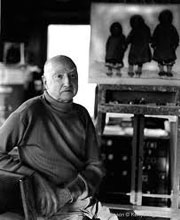Fred Machetanz
Valley Mourns Loss of Artist
Mat-Su Valley Frontiersman (Wasilla, AK) - Tuesday, October 8, 2002 Author/Byline: CASEY RESSLER-Valley Life editor

Fred Machetanz , one of the Valley's most beloved legends -- and one of the nation's most fabled artists -- died Sunday at Valley Hospital at the age of 94.
His art career spanned more than 70 years, and his paintings are among the most sought-after Alaska works. At the Palmer home he shared with his late wife, Sara, he used his paintbrush and his imagination as powerful tools, both in churning out paintings that still command top dollar and as an inspiration to other Alaskan painters.
"He's a giant. But not only for the quality of his work, which is just impeccable, but because of his contributions to other artists and the community," Palmer painter Gail Niebrugge said of Machetanz at his 90th birthday celebration four years ago. "He's one of Alaska's most significant painters."
His work is considered to be among the best and most distinctive art ever produced relating to Alaska. He is held in the same regard as Sydney Laurence, another notable Alaskan artist. But as much as he was one of the most well-known artists of his time, Machetanz was just as happy being an ordinary Palmer resident. He and his family donated large parcels of their Palmer land to the University of Alaska, and his family's contributions to the community are too numerous to list.
He frequently taught painting and art classes to Palmer High School students, and his love of Palmer High School was second to none. The reciprocal love of the Machetanz family by the Palmer High community is just as strong.
The football field at Palmer High School bears the name " Machetanz Field," and he rarely missed a home game. He made an appearance at the Potato Bowl just two Fridays ago, and the entire PHS squad shook his hand at the end of the game and saluted him with the "Let's Get 'Em" cheer Machetanz always said. After being presented with the Mayor's Cup trophy, Palmer running back Ari Larijani in turn presented it to Machetanz , whose son Traeger played football for the Moose.
The Valley has repeatedly honored the Machetanz family, from the Machetanz Building at Mat-Su College to the Fred and Sara Machetanz Theatre in Wasilla, in addition to the football field. They enjoyed living in a community they helped shape through the past 50 years.
Machetanz was born in 1908 in Kenton, Ohio. He trained in art at Ohio State University, producing several illustrations that were used for football program covers and other collegiate purposes. He also visited and trained with legendary artists like Norman Rockwell, N.C. Wyeth and Maxfield Parrish.
He earned a master's degree in art in 1935, the same year his love affair with Alaska began, when he first visited his uncle Charles Traeger's remote Unalakleet trading post. Although he left Alaska, he could not stay away and eventually returned. He met writer Sara Dunn on a steamship in Skagway, and the couple was married in Unalakleet.
In the early years, the Machetanzes filmed throughout the state and traveled on a lecture circuit in the Lower 48. In 1950, the couple settled in the Matanuska Valley on "High Ridge" near Palmer, with Pioneer Peak in the distance.
When first starting out, he would sell works for $500 each. In 1962, with the help of the late newspaper man Bob Atwood, Machetanz organized and promoted his first one-man show.
"It was a smashing success," the late Sara Machetanz recalled. "I had no idea his work would meet with the kind of success it did."
His works sold quickly during that first art show, and a legendary career was born. For nearly a decade, the Machetanzes lived in a cabin without electricity or running water. According to their only son, Traeger, the couple had to hike more than mile out to the main road to go to Palmer to do their laundry.
"Dad would paint and Mom would write in their cozy cabin. Ultimately, Mom and Dad collaborated on several books and Mom wrote four children's books that dad illustrated," Traeger said last year.
Machetanz used his travels as a source for his paintings. He continued the traditional frontier image through his paintings. He focused on Alaska animals, Native people, pioneers and dramatic landscapes. His oil paintings on masonite use ultramarine blue underpainting, followed by many traditional linseed oil glazes. The use of the deep blue color brought out the coldness of the Alaska Arctic, he said, and set the visual tone for his paintings. His originals are highly sought-after and his reproductions are in demand internationally.
Even after more than 60 years of observing and then recreating Alaska's Arctic landscape, wild animals and rugged characters, Machetanz was still painting into his 90s.
"That's what I'm interested in," he said during his 90th birthday celebration. "I'm happy I've had the chance to do these paintings and gather the material for them."
Machetanz is survived by his son Traeger and daughter-in-law Carolyn. He is also survived by two grandchildren, Alexander and Olivia.
UA Site named after Fred Machetanz
Links:
